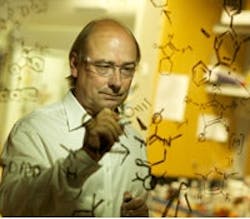Boron-based Catalysts Beckon
Researchers at the University of California Riverside have succeeded in making acidic boron compounds behave like bases. This opens up the opportunity to create boron-based catalysts that may suit a vast range of chemical reactions, believes Guy Bertrand, a professor of chemistry who led the research efforts (Figure 1).
The researchers modified the number of electrons in boron without altering the atom's nucleus. "It's almost like changing one atom into another atom," says Bertrand.
"The result is totally counterintuitive," he notes. "When I presented preliminary results from this research at a conference recently, the audience was incredulous, saying this simply was unachievable. But we have achieved it. We have transformed boron compounds into nitrogen-like compounds."
The development is important because boron compounds are acidic and acids can't be used as ligands to form a catalyst, he explains. Now, boron-based ligands may play a role.
"So far, all the ligands used for transition metal catalysts are based on group 14 to 16 elements. In other words, the catalytic community has been optimizing catalysts by only fine-tuning the structure of phosphines, amines and carbenes. Our discovery paves the way for using group 13 elements, something totally different; in other words, we create a gap. Will the corresponding complexes be more efficient than those used today remains to be seen, and this is unpredictable."
Boron-based ligands may particularly appeal for replacing the phosphorus-based ones found in many current catalysts. "The trouble with phosphorus-based catalysts is that phosphorus is toxic and it can contaminate the end products," Bertrand says. "Our work shows that it is now possible to replace phosphorous ligands in catalysts with boron ligands. And boron is not toxic… Our work is a quantum leap in catalyst research because a vast family of new catalysts can be added to the mix. What kinds of reactions these boron-based catalysts are capable of facilitating is as yet unknown. What is known, though, is that they are potentially numerous."
"There are two major issues we have to address before going further: 1) to prepare a derivative in which the boron bears smaller substituents; [and] 2) to design a high efficient synthetic route.
"As soon as the two issues mentioned above have been solved, we will prepare a variety of transition metal complexes supported by our boron-based ligands. At the beginning we will focus on complexes [that are] known to be efficient catalysts when the metal bears phosphine ligands," adds Bertrand.
While the robustness and efficiency of catalysts with boron-based ligands are difficult to predict, the catalysts likely will be much less sensitive to oxidation than phosphine-based ones, he expects.
Details on the research appear in an article in Science.

